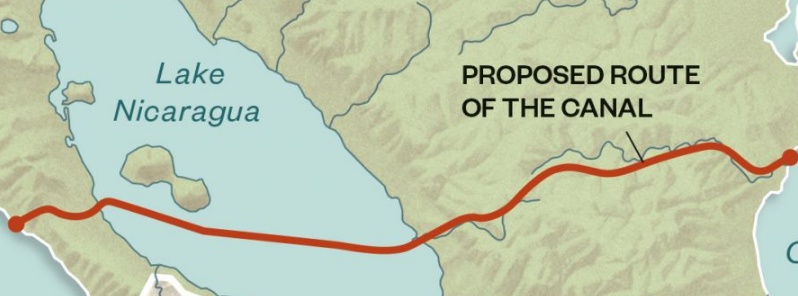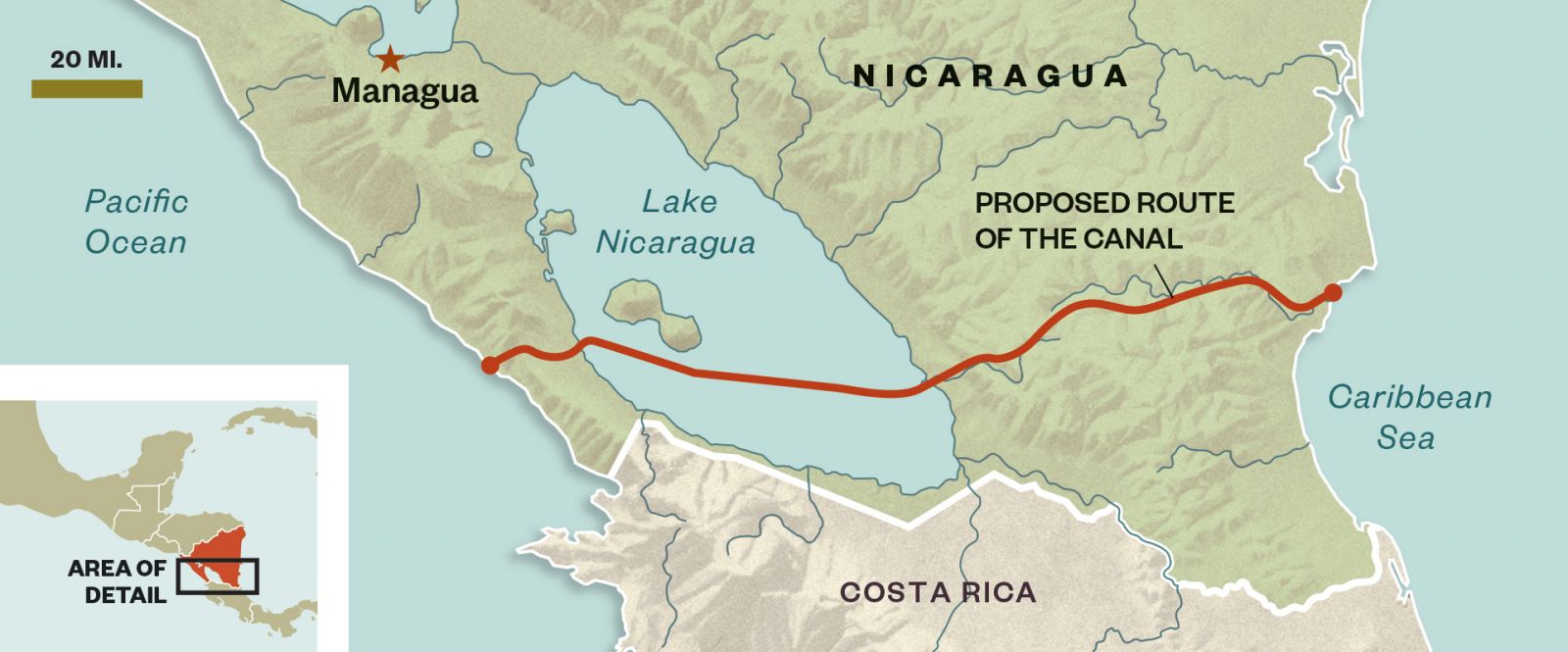Scientists question rush to build controversial Nicaragua canal

A consortium of environmental scientists has expressed strong concern about the impact of a controversial Central American canal to be built across Nicaragua. The 172-mile long (276 km) Nicaragua Interoceanic Grand Canal is suppose to connect the Atlantic and Pacific oceans through Lake Nicaragua (Lake Cocibolca), Central America’s main freshwater reservoir and the largest tropical freshwater lake of the Americas.
The concession was granted last June and preparation for the project has already begun with the construction of roads to move heavy equipment and supplies into place. This will be longer, wider and deeper canal than the 51-mile (82 km) Panama Canal to the south. First ships are scheduled to pass through the canal in late 2019.
According to environmental engineer Pedro Alvarez and other members of the consortium, this plan will force the relocation of indigenous populations and impact a fragile ecosystem, including species at risk of extinction.
Alvarez is co-corresponding author of an article that includes 21 co-authors from 18 institutions in the United States and Central and South America who gathered at a multidisciplinary international workshop in Managua, Nicaragua, last November to discuss the project, Rice University writes.
The paper, titled “Scientists Raise Alarms About Fast Tracking of Transoceanic Canal Through Nicaragua,” was published last week by the American Chemical Society journal Environmental Science and Technology.
“The biggest environmental challenge is to build and operate the canal without catastrophic impacts to this sensitive ecosystem,” Alvarez said. “Significant impacts to the lake could result from incidental or accidental spills from 5 100 ships passing through every year; invasive species brought by transoceanic ships, which could threaten the extinction of aquatic plants and fish, such as the cichlids that have been evolving since the lake’s formation; and frequent dredging, impacting aquatic life through alterations in turbidity and hypoxia, triggered by resuspension of nutrients and organic matter that exert a relatively high biochemical oxygen demand.”
Alvarez and his colleagues, including co-correspondent author Jorge Alberto Huete-Pérez, vice-rector and director of the Molecular Biology Center at the University of Central America in Managua, Nicaragua, wrote that dredging required to open a channel in the lake deep and wide enough for ships will disperse enough sediment to lower its oxygen content and kill marine life. They anticipate the project will impact Nicaragua’s lucrative ecotourism and the supply of fresh water for drinking, irrigation and power generation.
The new canal and its infrastructure, from roads to pipelines to power plants, will destroy or alter nearly one million acres of rainforest and wetlands, Matthew Shaer wrote for the SmithsonianMag. And that doesn’t include Lake Nicaragua which provides most Nicaraguans with drinking water, he added.
Robert Stallard, a research hydrologist with the USGS and the Smithsonian Tropical Research Institute said the canal route lies in the middle of a hurricane belt.
“You’re likely going to be looking at hurricanes vastly more powerful than anything that ever hit Panama, and ever will,” Stallard says. A storm like Hurricane Mitch, which killed 3 800 people in Nicaragua in 1998, would probably cause the canal to flood, triggering mudslides that would breach locks and dams. Communities, homes, roads and power lines would be swamped.

Image credit: Guilbert Gates
In a January editorial in Science, Alvarez, Huete-Perez and Axel Meyer, a professor of biology at the University of Konstanz Germany, wrote, “It is incumbent upon scientists, human rights advocates, nongovernmental organizations and wildlife protection organizations to share knowledge, voice concerns, provide guidance and demand a greater role for science in the design and construction of this massive project.”
They called for the international scientific community to help “analyze design plans of the canal and its subprojects for safety, social responsibility and sustainability; make recommendations to protect the region’s water resources and biodiversity; and draft statements urging the Nicaraguan government to halt construction until studies can be performed and evaluated by experts.
“In this matter of great urgency and importance, this is an opportunity to exercise scientific leadership, raise awareness and contribute to averting a potential environmental disaster,” they wrote.
Nicaragua is among countries considered most vulnerable to climate change, the researchers wrote in their latest paper. They are concerned that changes to the watershed could lead to a shortage of water in the event of drought and catastrophic weather events.
The researchers listed their concerns in three broad categories: water and sediments, biodiversity and ecosystem integrity, and socio-economic impact. “Each category involves a number of complex considerations, rendering proper analysis a weighty challenge that is compounded by a lack of publicly available information” from the government and the project’s developers and consultants, they wrote.
They acknowledged Nicaragua’s hope that the canal, one of the largest engineering projects ever attempted, would create jobs and lift the nation out of extreme poverty; but they are concerned the benefits would not match expectations, particularly since the Nicaraguan government “has not published a detailed business plan for the canal.”
“Nicaragua should prepare and publicly vet a detailed economic assessment that includes not only a cost-benefit analysis but also considers externalities associated with national economic development, environmental impacts, social equity, human rights and legal and national security issues,” they wrote.
Alvarez is the George R. Brown Professor and chair of Rice’s Civil and Environmental Engineering Department and a member of the Environmental Protection Agency’s science advisory board. Alvarez and Huete-Pérez are members of the Academy of Sciences of Nicaragua, of which Huete-Pérez is vice president. The meeting was organized with support from the InterAmerican Network of Academies of Science and the International Council for Science-Regional Office for Latin America and the Caribbean.
The construction of manmade waterway through Central America – using the San Juan River as an access route to Lake Nicaragua – was first proposed in the early colonial era.
Sources: Rice University, SmithsonianMag
Featured image: The proposed route of Nicaragua Interoceanic Grand Canal. Image credit: Guilbert Gates.

Exactly right do.
They will, of course have big fat wallets for doing their duty to the most corrupt globalists in the world.
Reminiscent of the DoA and GMO’s, and the FDA and all the vaccine issues.
Sick to the core.
“Alvarez is co-corresponding author of an article that includes 21 co-authors from 18 institutions in the United States”
there is your catch.
this canal is going to rival panama canal and end the us domination of ship traffic to and from atlantic ocean. which, usa is using as a means to prevent other countries from moving their navies about.
this is why the canal is an ‘environmental concern’. and numerous ‘institutions’ from usa is ‘expressing concern’ about it.
usual corporate fascist bullcrap.